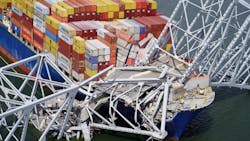Key Bridge Could Have Lacked Collision Protective Measures
In the aftermath of the collapse of Baltimore's Francis Scott Key Bridge, engineering and infrastructure policy experts say the tragic event exemplifies the need for bridge reform and updates to policy surrounding large cargo ships in the United States.
The Key Bridge partially collapsed early Tuesday morning after a massive cargo ship collided with one of the bridge's support columns, sending vehicles into the Patapsco River below.
While the investigation into the cause of the collision and the bridge collapse is ongoing, Rick Geddes, infrastructure policy expert and director of the Cornell University Infrastructure Policy Program, weighed in on the infrastructure and safety of the Key Bridge.
"This disaster reveals how exposed America's critical infrastructure is to sudden and devastating accidents as well as intentional destruction," Geddes said in a statement to ABC News. "I think the bridge was not designed to take the force and the mass of an enormous cargo ship directly hitting one of the pylons.”
Pylons, or piers, are the critical load-bearing components of cable-supported bridges, such as Baltimore's Key Bridge, a 1.6-mile-long, continuous truss-style bridge, according to Geddes.
Modern protective measures for bridge piers include adding "fenders," which are protection systems designed to protect the bridge from vessels transiting under or in the vicinity of the bridge, according to the U.S. Coast Guard.
Fenders on modern bridges include "dolphins," which are large circular walls filled with material such as sand or concrete and "artificial islands," armored artificial islands around the piers made of a sand core that is protected against wave and current action by armored slope protection, according to the Coast Guard.
However, it is not yet known whether the Key Bridge had fenders at the time of the crash.
Transportation Secretary Pete Buttigieg also weighed in on the bridge's ability to withstand a massive cargo ship collision Wednesday, "What we do know is a bridge like this one completed in the 1970s was simply not made to withstand a direct impact on a critical support pier from a vessel that weighs about 200 million pounds," he said in a statement.
"Right now, I think there's a lot of debate taking place in the engineering community about whether or not any of those features could have had any role in a situation like this," Buttigieg added.
Maria Lehman, former president of the American Society of Civil Engineers, said in a statement to ABC News that older bridges are not designed with the post Panama Canal expansion ship allowances in mind.
In 2016, the Panama Canal expansion project constructed pathways -- on both the Atlantic and Pacific ends of the canal -- that are 70 feet wider and 18 feet deeper, to accommodate larger cargo ships.
"Pier protection on long-span bridges that have been built within the last decade are in line with what you're gonna need based on how heavy these new ships are," Lehman said.
The Key Bridge was constructed in 1977 and did not have the protected pier measures that bridges built in the decades since this advisory.
"Unless you're doing a major retrofit of any piece of infrastructure, you don't have to bring it up to code," Lehman said, adding that the Key Bridge collapse is a "wake-up" call for better bridge infrastructure and reform.
Rick Geddes hopes the devastation from the Key Bridge collapse will spur great reform in America's bridge infrastructure safety.
"The real possibility of a massive container ship of this size, running into a bridge pylon, and causing the bridge collapse is no longer theoretical," Geddes said. "I think a renewed effort to inspect and assess the state of a whole bunch of U.S. bridges will be the result of this accident."
---------------------------------
Source: ABC News
